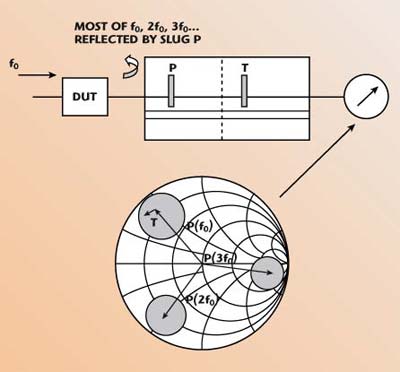Load-pull testing of power transistors usually employs wideband electromechanical tuners. Harmonic signal components, generated by a nonlinear device under test (DUT), must be terminated with known impedances in order to generate a meaningful set of data. This is not possible if a harmonic load-pull set-up is not available, in which case distorted data will be generated. Using wideband, high VSWR, prematching tuners instead of harmonic tuners improves the situation, but creates limitations in harmonic tuning. This note compares the effect of the different configurations of tuner set-ups based on sample measurements at 2.6 GHz.
 | |||
| Fig. 1 Load-pull using wideband tuners. | |||
Load-pull contours, measured using wideband electromechanical tuners, are usually part of the literature and transistor manufacturer’s data sheets. In many cases, however, these contours have been measured using a simple load-pull set-up, as shown schematically in Figure 1. The harmonic signal components, generated by the DUT at 2f0, 3f0, … are reflected simultaneously with f0 by the source and load tuners. When tuning at f0, the impedances at 2f0, 3f0, … also change uncontrollably at both the source and load side. This creates distorted load-pull contours, as shown in Figure 2. These contours have been measured using wideband 0.8 to 18 GHz tuners at the source and load. The same test was performed using the same tuners for fundamental tuning, but with two additional harmonic rejection tuners (Focus PHT-1808). The harmonic tuners were set to reflect the harmonic signals at 2f0 (5.2 GHz) and 3f0 (7.8 GHz) back into the transistor at optimal phase. The results are shown in Figure 3. The effect of uncontrollable harmonic tuning is obvious when comparing the two figures. The contour distortions obtained with the wideband tuners is difficult to detect as a measurement error, since the maximum power and the optimum fundamental load impedance itself may not be very different, especially at moderate saturation levels. This is because a wideband tuner optimizes for all harmonic impedances simultaneously, producing a result that is a combination of fundamental and harmonic tuning. This systematic measurement error becomes disturbing when an amplifier design attempt is made using such data. The load circuit is not designed for maximum output power only, but most often is a compromise between multiple parameters such as Pout, PAE, IMD, etc. In this case, the data on the contour may be several decibels off the real value.
 | ||
| Fig. 2 Load-pull contours of a power FET showing distortions. | ||
 | ||
| Fig. 3 Load-pull contours of the same device with harmonic rejection tuners added. | ||
Using a Prematching Tuner
A prematching tuner consists of a prematching slug (P) close to the DUT, which does not move during load-pull, followed by a tuning slug (T) (see Figure 4), which serves for the actual load-pull measurements (gray areas). Both the prematching and the tuning slugs are typically wideband. When the prematching slug P is set close to the center conductor of the airline to create a high (wideband) reflection, then most of the RF power at the harmonic frequencies is reflected at the prematching slug and only a small fraction reaches the tuning slug. Thus, very low uncontrolled harmonic tuning occurs when tuning slug T is used for load-pull or peak search operations. The load-pull contours are less distorted. However, it is not possible to tune or optimize effectively the harmonic impedances by tuning behind the prematching slug, using neither a wideband tuning slug or a harmonic rejection tuner. This is why a harmonic tuner must be inserted between the DUT and the prematching slug P.
 | ||
| Fig. 4 Prematching tuner with two independent slugs. | ||
Conclusion
Wideband passive tuners always create undesired harmonic tuning during load-pull and therefore falsify the data. The use of harmonic load-pull, in the form of harmonic rejection tuners or frequency discriminators, is mandatory.
